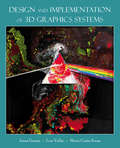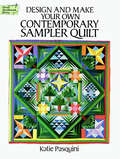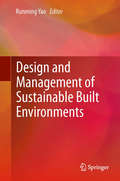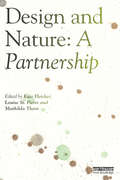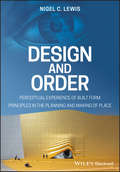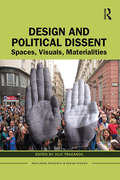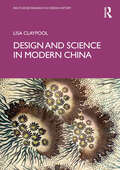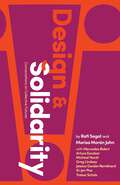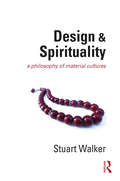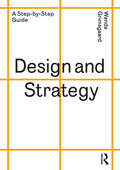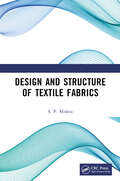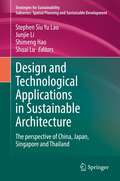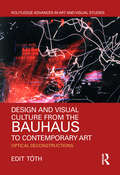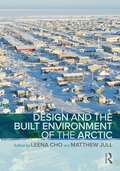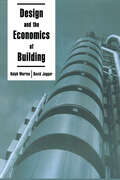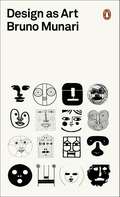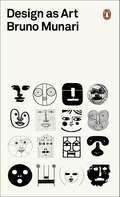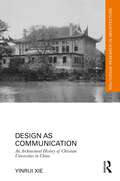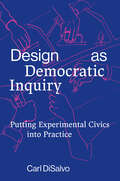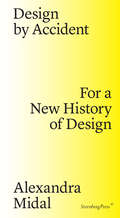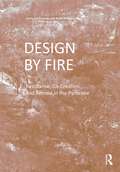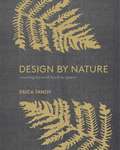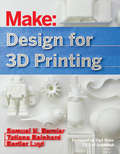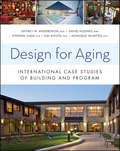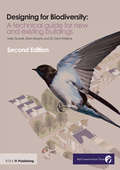- Table View
- List View
Design and Implementation of 3D Graphics Systems
by Luiz Velho Jonas de Gomes Mario Costa SousaThis book covers the computational aspects of geometric modeling and rendering 3D scenes. Special emphasis is given to the architectural aspects of interactive graphics, geometric modeling, rendering techniques, the graphics pipeline, and the architecture of 3D graphics systems. The text describes basic 3D computer graphics algorithms and their implementation in the C language. The material is complemented by library routines for constructing graphics systems, which are available for download from the book's website.
Design and Make Your Own Contemporary Sampler Quilt
by Katie PasquiniHow to combine traditional patterns into pre-planned layout to create handsome, one-of-a-kind quilts. 100 block plans.
Design and Management of Sustainable Built Environments
by Runming YaoClimate change is believed to be a great challenge to built environment professionals in design and management. An integrated approach in delivering a sustainable built environment is desired by the built environment professional institutions. The aim of this book is to provide an advanced understanding of the key subjects required for the design and management of modern built environments to meet carbon emission reduction targets. In Design and Management of Sustainable Built Environments, an international group of experts provide comprehensive and the most up-to-date knowledge, covering sustainable urban and building design, management and assessment. The best practice case studies of the implementation of sustainable technology and management from the BRE Innovation Park are included. Design and Management of Sustainable Built Environments will be of interest to urban and building designers, environmental engineers, and building performance assessors. It will be particularly useful as a reference book for undergraduate and postgraduate students in the built environment field.
Design and Nature: A Partnership
by Louise St. Pierre Kate Fletcher Mathilda ThamOrganised as a dialogue between nature and design, this book explores design ideas, opportunities, visions and practices through relating and uncovering experience of the natural world. Presented as an edited collection of 25 wide-ranging short chapters, the book explores the possibility of new relations between design and nature, beyond human mastery and understandings of nature as resource and by calling into question the longstanding role for design as agent of capitalism. The book puts forward ways in which design can form partnerships with living species and examines designers’ capacities for direct experience, awe, integrated relationships and new ways of knowing. It covers: • New design ethics of care • Indigenous perspectives • Prototyping with nature • Methods for new design and nature relations • A history of design and nature • Animist beliefs • De-centering human-centered design • Understanding nature has power and agency Design and Nature: A Partnership is a rich resource for designers who wish to learn to engage with sustainability from the ground up.
Design and Order: Perceptual Experience of Built Form - Principles in the Planning and Making of Place
by Nigel C. LewisTeaches the principles behind the successful planning and creation of inspired built forms and urban places This book offers an integrated understanding of both the principles and the perception of the design of built environments and public spaces. It outlines the fundamental characteristics that are evident in the creation of built form and illustrates how they determine the experience of resultant places. It also consolidates the key criteria that need to be taken into consideration in the development of these areas. All of the above-mentioned aims to provide designers with a solid understanding of the implications of their decisions on perception and behavior during the creation of new spaces. Design and Order: Perceptual experience of built form - Principles in the Planning and Making of Place starts by examining the designing of natural environments and the affect that they have on humans. It teaches readers how people experience and are shaped by a space—via their eyes, brain, and overall perception. It then instructs on proper grammar of form and syntax so that designers can understand how to pursue design processes systematically. The book then takes readers through this process of designing, informing them on the principles of form, function, configuration, communication, organization, color and contrasts, building structures, good practice and more. Seeks to improve the methodological approach to the planning and design of buildings Broadly address all of the functions that impact the realization of new built and urban form Outlines the fundamental characteristics that are evident in the design of built forms and illustrates how these characteristics determine the experience of the resultant places Comprehensively covers the ideas, principles, and the perception of design Teaches designers to make informed decisions about applying or discarding principles when creating spaces. Design and Order is a unique book that will appeal to students and professionals in architecture, urban design and planning, as well as designers and developers.
Design and Political Dissent: Spaces, Visuals, Materialities (Routledge Research in Design Studies)
by Jilly TraganouThis book examines, through an interdisciplinary lens, the relationship between political dissent and processes of designing. In the past twenty years, theorists of social movements have noted a diversity of visual and performative manifestations taking place in protest, while the fields of design, broadly defined, have been characterized by a growing interest in activism. The book’s premise stems from the recognition that material engagement and artifacts have the capacity to articulate political arguments or establish positions of disagreement. Its contributors look at a wide array of material practices generated by both professional and nonprofessional design actors around the globe, exploring case studies that vary from street protests and encampments to design pedagogy and community-empowerment projects. For students and scholars of design studies, urbanism, visual culture, politics, and social movements, this book opens up new perspectives on design and its place in contemporary politics.
Design and Science in Modern China (Routledge Research in Design History)
by Lisa ClaypoolWhat is design in modern China? And what are the ecological stakes in understanding how modern Chinese design encourages us to see? This book takes up these questions though exploration into the work of three famous designers who were actively engaged with the natural sciences in early twentieth-century Shanghai, Canton, and Beijing.The designed objects asking for heightened vision into interior and exterior worlds make their way across temporal and cultural boundaries. This book, then, is also about that movement, and the emotions of the eye which support it. Porcelain dishes, textiles, magazine covers, and paintings moved the people who lived with them a century ago in China to an awareness of their edges, rims, borders as boundary lines, and to see things through those in-between forms from a new point of view; to share pleasure in colour and pattern, perhaps, but also to connect to other deeply transformative feelings at the boundary.The book will be of interest to scholars working in design history, art history, and Chinese studies.
Design and Solidarity: Conversations on Collective Futures
by Rafi Segal Marisa Morán JahnIn times of crisis, mutual aid becomes paramount. Even before the COVID-19 pandemic, new forms of sharing had gained momentum to redress precarity and stark economic inequality. Today, a diverse array of mutualistic organizations seek to fundamentally restructure housing, care, labor, food, and more. Yet design, art, and architecture play a key role in shaping these initiatives, fulfilling their promise of solidarity, and ensuring that these values endure.In this book, artist Marisa Morán Jahn and architect Rafi Segal converse about the transformative potential of mutualism and design with leading thinkers and practitioners: Mercedes Bidart, Arturo Escobar, Michael Hardt, Greg Lindsay, Jessica Gordon Nembhard, Ai-jen Poo, and Trebor Scholz. Together, they consider how design inspires, invigorates, and sustains contemporary forms of mutualism—including platform cooperatives, digital-first communities, emerging currencies, mutual aid, care networks, social-change movements, and more. From these dialogues emerge powerful visions of futures guided by communal self-determination and collective well-being.
Design and Spirituality: A Philosophy of Material Cultures
by Stuart WalkerDesign and Spirituality examines the philosophical context of our current situation and its implications for design. It explores how modernity and our constricted notions of progress have contributed to today’s crisis of values, and argues for a re-establishment and re-affirmation of self-transcending priorities, together with an ethos of moderation and sufficiency. A wide range of topics are covered, including material culture and spiritual teachings; sustainability and the spiritual perspective; traditional and indigenous knowledge; technology and spirituality; notions of meaningful design; and how particular material things can have deeper, symbolic significance. There are also reflections on areas such as the language of design; busyness and its relationship to wisdom; design and social disparity; and traditional sacred practices. While not avoiding issues that are controversial, and sometimes hard-hitting, Design and Spirituality gets to the heart of the key issues affecting us today and presents them in a highly readable and accessible format. The author is a leading thinker in the field and he presents his arguments in a manner that invites the reader to reflect and think about where we are going, why we are going there and what really matters.
Design and Strategy: A Step-by-Step Guide
by Wanda GrimsgaardThis major practical handbook bridges the gap between strategy and design, presenting a step-by-step design process with a strategic approach and extensive methods for innovation, strategy development, design methodology and problem solving. It is an effective guide to planning and implementing design projects to ensure strategic anchoring of the process and outcome. Built around a six-part phase structure that represents the design process, covering initial preparations and project briefing, research and analysis, targets and strategy, concept development, prototyping and modelling, production and delivery, it is a must-have resource for professionals and students. Readers can easily dip in and out of sections, using the phase structure as a navigation tool. Unlike other books on the market, Design and Strategy addresses the design process from the perspective of both the company and the designer. For businesses, it highlights the value of design as a strategic tool for positioning, competition and innovation. For the designer, it teaches how to create solutions that are strategically anchored and deliver successful outcomes for businesses, resulting in appreciative clients. It includes over 250 illustrations and diagrams, tables, and text boxes showing how to move through each stage with clear visualisation and explanation. This book encourages all designers in product design and manufacturing, service design, communication design, branding, and advertising, to think beyond shape and colour to see design through the lens of strategy, process and problem solving, and all business managers, innovators and developers, to see the value in strategic design outcomes.
Design and Structure of Textile Fabrics
by S. P. MishraThis book details the development of textile products and deals with different aspects of fabric structure and textile design. It covers topics essential to understanding textile fabrics – such as intertwined and non-woven fabrics, pique design, mosaic knitting, and spot designs. The subject matter of this book also includes: Properties of plain, twill and satin weave Types of jacquard Tubular fabrics Two-bar fabric structure Color effect on twill weaves Print edition not for sale in South Asia (India, Sri Lanka, Nepal, Bangladesh, Pakistan or Bhutan)
Design and Technological Applications in Sustainable Architecture: The perspective of China, Japan, Singapore and Thailand (Strategies for Sustainability)
by Shuai Lu Stephen Siu Yu Lau Junjie Li Shimeng HaoThis volume discusses the climate responsiveness of sustainable architecture design and technology in China, Japan, Singapore, and South Korea in recent years, addressing concepts and applications in urban planning, building design, and structural performance evaluation. The four sections of the text cover the theory and implementation of sustainable architecture within various geographic boundaries and contexts, offering an interdisciplinary assessment of the challenges faced in urban areas at different climate zones. The main topics covered are: 1) urban ecological restoration under the influence of climate environment; 2) health and human considerations of building and environment; 3) prototype optimization of sustainable building, and 4) feedback of building performance and design evaluation. The book is intended to be a contribution to the growing body of knowledge on sustainable architecture for applicable use by practitioners, city planners, field researchers, and building operators in building design, construction, usage, operation, and maintenance.
Design and Visual Culture from the Bauhaus to Contemporary Art: Optical Deconstructions (Routledge Advances in Art and Visual Studies)
by Edit TóthThis book complements the more textually-based Bauhaus scholarship with a practice-oriented and creative interpretive method, which makes it possible to consider Bauhaus-related works in an unconventional light. Edit Toth argues that focusing on the functionalist approach of the Bauhaus has hindered scholars from properly understanding its design work. With a global scope and under-studied topics, the book advances current scholarly discussions concerning the relationship between image technologies and the body by calling attention to the materiality of image production and strategies of re-channeling image culture into material processes and physical body space, the space of dimensionality and everyday activity.
Design and the Built Environment of the Arctic
by Leena Cho Matthew JullDesign and the Built Environment of the Arctic is a concise introductory guide to the design and planning of the built environments in the Arctic region. As the global forces of change are becoming more pronounced in the Arctic, the future trajectories for living environments, city-making processes, and their adaptive capacities need to be addressed directly. This book presents 11 new and original contributions from both leading and emerging scholars and practitioners, positioning the Arctic as a dynamic, diverse, and lived place at the nexus of unprecedented socioenvironmental transformations. The volume offers key concepts for understanding and spatializing Arctic cities and landscapes; similarities and differences in the development of design and planning approaches responsive to specific climatic and cultural conditions; and historical and geographic case studies that provide unique perspectives for the management of the built environment, from the scales of a building and infrastructure to cities and territories. Altogether, the contributions expand regional Arctic design scholarship to understand how the variability of the Arctic context influences the designed urban, architecture, and landscape systems, and offer numerous lessons for design and other forms of spatial practice both within and beyond the Arctic. This is a unique resource for researchers, creative practitioners, policymakers, and community decision-makers, as well as for advanced undergraduate and graduate students.
Design and the Economics of Building
by D. Jaggar R R MortonA textbook on design economics for students of architecture, building and quantity surveying, it examines the links between design and the costs of building as well as more general economic issues and their significance for designers and builders.
Design as Art
by Bruno Munari<p>One of the last surviving members of the futurist generation, Bruno Munari's Design as Art is an illustrated journey into the artistic possibilities of modern design translated by Patrick Creagh published as part of the 'Penguin on Design' series in Penguin Modern Classics. <p>'The designer of today re-establishes the long-lost contact between art and the public, between living people and art as a living thing' <p>Bruno Munari was among the most inspirational designers of all time, described by Picasso as 'the new Leonardo'. Munari insisted that design be beautiful, functional and accessible, and this enlightening and highly entertaining book sets out his ideas about visual, graphic and industrial design and the role it plays in the objects we use everyday. Lamps, road signs, typography, posters, children's books, advertising, cars and chairs - these are just some of the subjects to which he turns his illuminating gaze. <p>How do we see the world around us? The Penguin on Design series includes the works of creative thinkers whose writings on art, design and the media have changed our vision forever. <p>Bruno Munari (1907-1998), born in Milan, was the enfant terrible of Italian art and design for most of the twentieth century, contributing to many fields of both visual (paint, sculpture, film, industrial design, graphics) and non-visual arts (literature, poetry). He was twice awarded the Compasso d'Oro design prize for excellence in his field.</p>
Design as Art (Penguin Modern Classics)
by Bruno MunariHow do we see the world around us? The Penguin on Design series includes the works of creative thinkers whose writings on art, design and the media have changed our vision forever. Bruno Munari was among the most inspirational designers of all time, described by Picasso as ‘the new Leonardo’. Munari insisted that design be beautiful, functional and accessible, and this enlightening and highly entertaining book sets out his ideas about visual, graphic and industrial design and the role it plays in the objects we use everyday. Lamps, road signs, typography, posters, children’s books, advertising, cars and chairs – these are just some of the subjects to which he turns his illuminating gaze.
Design as Communication: An Architectural History of Christian Universities in China (Routledge Research in Architecture)
by Yinrui XieThis book explores the architectural history of Christian universities in China, revealing how quasi‑colonial power interaction and cross‑cultural communication of meaning were channelled through religious and educational architecture in modern China.The Christian universities in China witnessed an experimental representation of Chinese architectural identity, as the country – subject to an informal version of colonialism – struggled to become a modern nation‑state and to rethink its identity. This book offers new knowledge to the prospering postcolonial studies of the architectural history of Asian countries, deepening our understanding of the scope and content of the nuanced colonial encounters between the East and the West, and the relationship between architecture and power. Borrowing ideas from architectural semiotics, this book explores how architectural meaning has been interpreted and sometimes modified by its audience(s), whose voice has been largely ignored in traditional architectural historical studies. It provides a unique scope to further understand the communicative function of architecture, throwing light upon the broader socio‑cultural dialogue between China and the Western world in the twentieth century.Design as Communication will be an enriching reference for those interested in the architectural dialogue between China and the West, architecture and postcolonialism and the localisation of Christianity in the world.
Design as Democratic Inquiry: Putting Experimental Civics into Practice
by Carl DisalvoThrough practices of collaborative imagination and making, or "doing design otherwise,&” design experiments can contribute to keeping local democracies vibrant.In this counterpoint to the grand narratives of design punditry, Carl DiSalvo presents what he calls &“doing design otherwise.&” Arguing that democracy requires constant renewal and care, he shows how designers can supply novel contributions to local democracy by drawing together theory and practice, making and reflection. The relentless pursuit of innovation, uncritical embrace of the new and novel, and treatment of all things as design problems, says DiSalvo, can lead to cultural imperialism. In Design as Democratic Inquiry, he recounts a series of projects that exemplify engaged design in practice. These experiments in practice-based research are grounded in collaborations with communities and institutions. The projects DiSalvo describes took place from 2014 to 2019 in Atlanta. Rather than presume that government, industry—or academia—should determine the outcome, the designers began with the recognition that the residents and local organizations were already creative and resourceful. DiSalvo uses the projects to show how design might work as a mode of inquiry. Resisting heroic stories of design and innovation, he argues for embracing design as fragile, contingent, partial, and compromised. In particular, he explores how design might be leveraged to facilitate a more diverse civic imagination. A fundamental tenet of design is that the world is made, and therefore it could be made differently. A key concept is that democracy requires constant renewal and care. Thus, designing becomes a way to care, together, for our collective future.
Design by Accident: For a New History of Design
by Alexandra MidalA counterhistory and new historiography of design.In Design by Accident, Alexandra Midal declares the autonomy of design, in and on its own terms. This meticulously researched work proposes not only a counterhistory but a new historiography of design, shedding light on overlooked historical landmarks and figures while reevaluating the legacies of design's established luminaries from the nineteenth century to the present. Midal rejects both linear narratives of progress and the long-held perception of design as a footnote to the histories of fine art and architecture. By weaving critical analysis of the canon of design history and theory together, with special attention to the writings of designers themselves, she draws out the nuances and radical potentials of the discipline—from William Morris's ambivalence toward industry, to Catharine Beecher's proto-feminist household appliances, to the Bauhaus's Expressionist origins, and the influence of Herbert Marcuse on Joe Colombo.
Design by Fire: Resistance, Co-Creation and Retreat in the Pyrocene
by Emily Schlickman Brett MilliganAcross the world, the risks of wildfires are increasing and expanding. Due to past and current human actions, we dwell in the age of fire – the Pyrocene – and the many challenges and climate adaptation questions it provokes. Exploring our past and current relationships with fire, this book speculates on the pyro futures yet to be designed and cared for. Drawing upon fieldwork, mapping, drone imagery, and interviews, this publication curates 27 global design case studies within the vulnerable and dynamic wildland-urban interface and its adjacent wildlands. The book catalogs these examples into three approaches: those that resist the creative and transformative power of fire and forces of landscape change, those that embrace and utilize those forces, and those that intentionally try to retreat and minimize human intervention in fire-prone landscapes. Rather than serving as a book of neatly packaged solutions, it is a book of techniques to be considered, tested, and evaluated in a time of fire.
Design by Nature: Creating Layered, Lived-in Spaces Inspired by the Natural World
by Ngoc Minh Ngo Erica TanovThe first design book that translates elements of nature--including flora, water, and wood--into elements of decor for beautiful, lived-in, bohemian interiors, from acclaimed designer and tastemaker Erica Tanov. Inspired by nature's colors, textures, and patterns, design icon Erica Tanov uses her passion for textiles to create beautiful, timeless interiors that connect us to the natural world. Now, in her first book, Design by Nature, Tanov teaches you how to train your eye to the beauty of the natural world, and then bring the outdoors in—incorporating patterns and motifs from nature, as well as actual organic elements, into simple ideas for everyday decorating and design. Design by Nature contains new and imaginative decorating ideas for an organic and bohemian style that mixes and layers rugs, pillows, throws, and drapery, and incorporates unique patterns and fabrics such as shibori, ikat, and jamdani, all stunningly photographed by renowned photographer Ngoc Minh Ngo. With topics ranging from embracing imperfection in your home, to seeking out flea markets, to displaying your collections, Design by Nature takes an enduring and intuitive approach to design that transcends fleeting trends and encourages you to find your own personal style, source of creativity, and connection to the natural world. You don't need to travel to distant locales to find beauty; it's all around us, from the crackle of fallen leaves to the jagged bark of a tree.
Design for 3D Printing: Scanning, Creating, Editing, Remixing, and Making in Three Dimensions
by Bertier Luyt Samuel N. Bernier Tatiana ReinhardFrance's Le FabShop has extensive experience testing 3D printers and creating digital models for them. From an articulated Makey Robot to a posable elephant model, Samuel N. Bernier and the rest of Le FabShop's team have created some of the most-printed designs in the 3D printing world. This book uses their work to teach you how to get professional results out of a desktop 3D printer without needing to be trained in design. Through a series of tutorials and case studies, this book gives you the techniques to turn a product idea into a 3D model and a prototype. Focusing on free design software and affordable technologies, the exercises in this book are the perfect boost to any beginner looking to start designing for 3D printing. Designing for the tool and finding a good tool to fit the design--these are at the core of the product designer's job, and these are the tools this book will help you master. Foreword by Carl Bass, Autodesk's CEO, a passionate and prolific Maker. In Design For 3D Printing, you'll:Learn the different 3D printing technologiesChoose the best desktop 3D printerDiscover free 3D modeling softwareBecome familiar with 3D scanning solutionsFind out how to go from a bad to a good 3D source file, one that's ready-to-print
Design for Aging
by David Hughes Jeffrey Anderzhon Faia Riba Stephen Judd Emi Kiyota Monique Wintjies B. O. T.Architecture/Interior Design An in-depth look at the most innovative aged care facilities today With the world's population aging at a rapid pace, there is a growing need for new ways to provide residential care for older people. Design for Aging explores some of the most successful examples of elderly housing today, focusing on integrating architectural considerations within an unwavering people-driven approach. Written by an international team of experts in aged care design, the book brings together twenty-six case studies from around the world, including Australia, Denmark, England, Japan, the Netherlands, Sweden, and the United States. The authors describe how each scheme has succeeded in addressing the needs of its residents regardless of wide variations in design, geography, cultural factors, medical needs, capital cost, and other factors. Clear, well-documented information for each facility includes: Building descriptions and project data, and how the overall design fits within a geographical location The type of community, including number of residents, ethnicity, and specific conditions such as dementia How to apply universal design principles in different political, social, and regulatory contexts How to create a sense of belonging and well-being for residents while building strong connections with the community at large What makes a facility able to attract and retain high-quality caregivers Environmental sustainability issues, plus indoor and outdoor spaces Architects and interior designers as well as facility owners and caregivers will find Design for Aging an inspiring and practical guide on how to navigate the many factors involved in creating good designs for aged care environments.
Design for Biodiversity: A Technical Guide for New and Existing Buildings
by Carol Williams Brian Murphy Kelly GunnellThe built environment has the potential to have a major impact on biodiversity, not least with the increasingly demanding requirements to design more energy efficient and airtight buildings, leaving less space for species to inhabit. The construction industry has an important role to play in ensuring that buildings are designed and refurbished in a way in which biodiversity can be enhanced. Through written guidance and architectural drawings, this book advises on how to incorporate provision for biodiversity within developments. With sections on different building-reliant species, general principles for design, ready-made products that be incorporated into designs, and legislation, policy and regulations, this book is an invaluable resource for all architects, ecologists and anyone involved in designing or briefing for biodiversity in buildings.
